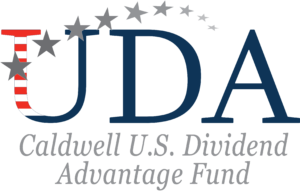For the month of February, the Caldwell U.S. Dividend Advantage Fund (“UDA”) declined 1.5% versus a decline of 3.3% for the S&P 500 Total Return Index (“Index”)1. Energy was the strongest performing sector for the second consecutive month as concerns about potential sanctions on Russian energy exports and the resulting impact on an already tight market caused a sharp rally in energy prices.
Top contributors to UDA performance in February were Devon Energy (“DVN”, +17.4%), Northrop Grumman (“NOC”, +19.6%) and L3 Harris (“LHX”, +20.2%). In addition to a highly supportive oil price environment, shares of DVN moved higher following a solid earnings report and full year outlook.
The Fund initiated positions in two new companies during February: CME group (“CME”) and Booz Allen Hamilton (“BAH”).
CME is a leading derivatives exchange operator with products across most major asset classes. Rising volatility and an impending interest rate hike cycle should benefit transaction volumes in core product areas such as Rates and FX which saw unusually low levels of volatility over the last two years.
Rising rates and inflation continue to dominate the market narrative, especially since the former poses a risk to higher multiple stocks that currently have an outsized weighting in major market benchmarks.
1 Standard performance as at February 28, 2022: Caldwell U.S. Dividend Advantage Fund Series F: 1 Year: 10.6%, 3 year: 11.7%, 5 year: 8.3%, Since Inception (June 19, 2015): 8.9%.
S&P500 Total Return Index: 1 Year: 16.6%, 3 year: 16.8%, 5 year: 14.2%, Since Inception (June 19, 2015): 14.2%.
2 Actual investments, first purchased: DVN 10/25/2021, LHX 11/11/2019, NOC 1/7/2022.
All data is as of February 28, 2022 sourced from Morningstar Direct or S&P Capital IQ, unless otherwise indicated. Fund returns are from FundData. UDA, Index total return numbers, sector returns and individual stocks returns are in CAD terms. The Fund was first offered to the public as a closed-end investment since May 28, 2015. Effective November 15, 2018 the Fund was converted into an open-end mutual fund such that all units held were redesignated as Series F units. Performance prior to the conversion date would have differed had the Fund been subject to the same investment restrictions and practices of the current open-end mutual fund.
The information contained herein provides general information about the Fund at a point in time. Investors are strongly encouraged to consult with a financial advisor and review the Simplified Prospectus and Fund Facts documents carefully prior to making investment decisions about the Fund. Commissions, trailing commissions, management fees and expenses all may be associated with mutual fund investments. Rates of returns, unless otherwise indicated, are the historical annual compounded returns including changes in unit value and reinvestment of all distributions and do not take into account sales, redemption, distribution or optional charges or income taxes payable by any unitholder that would have reduced returns. Mutual funds are not guaranteed; their values change frequently and past performance may not be repeated. The payment of distributions should not be confused with a fund’s performance, rate of return or yield. If distributions paid are greater than the performance of the fund, your original investment will shrink. Distributions paid as a result of capital gains realized by a fund, and income and dividends earned by a fund, are taxable in your hands in the year they are paid. Your adjusted cost base (“ACB”) will be reduced by the amount of any returns of capital and should your ACB fall below zero, you will have to pay capital gains tax on the amount below zero.
Publication date: March 11, 2022.
